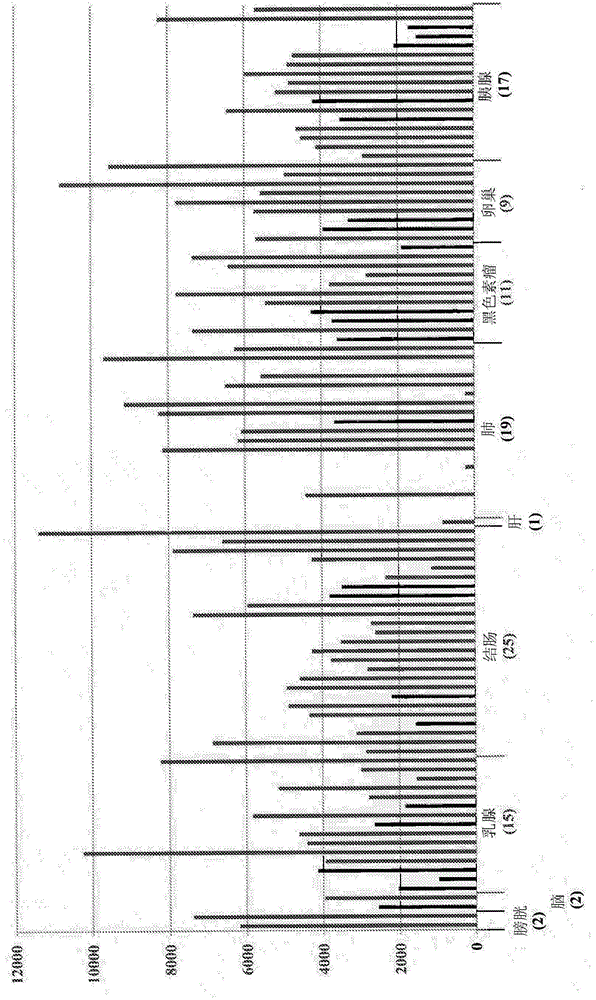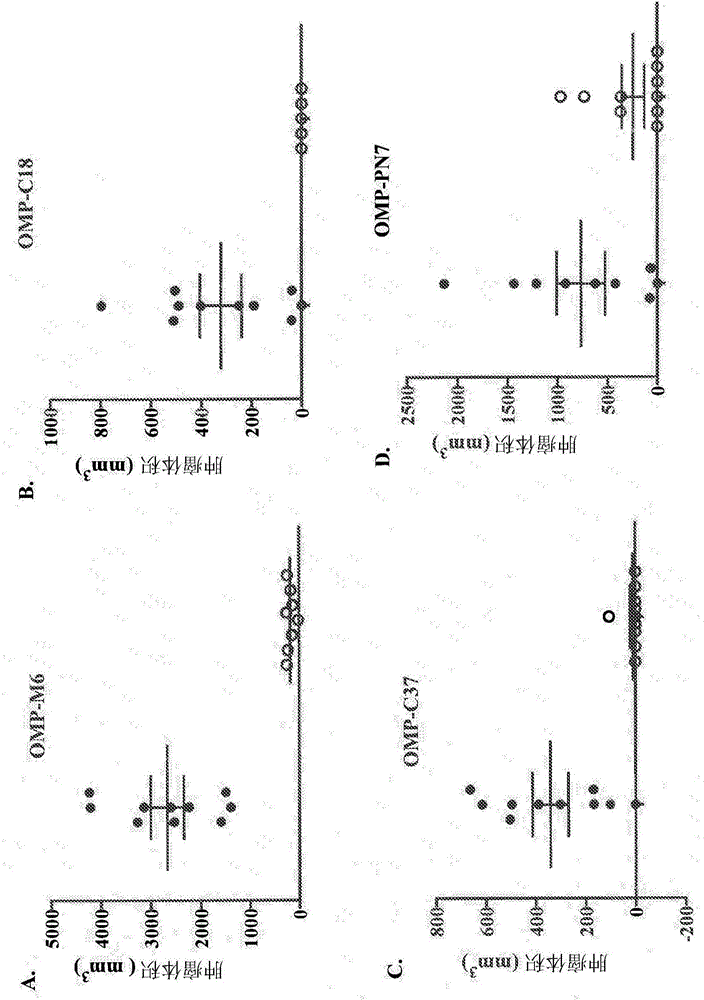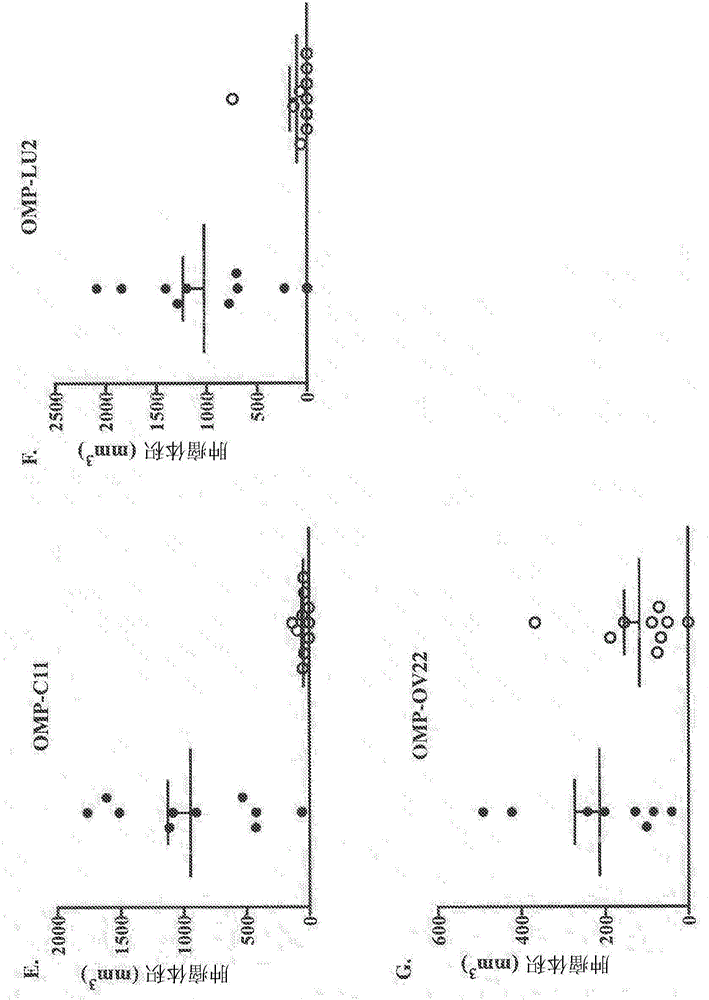Binding agents that modulate the hippo pathway and uses thereof
A technology of pathways and reagents, applied in the field of disease, which can solve the problem of not identifying cell surface receptors, etc.
- Summary
- Abstract
- Description
- Claims
- Application Information
AI Technical Summary
Problems solved by technology
Method used
Image
Examples
Embodiment 1
[0282] Expression of YAP in OMP tumors
[0283] Microarray gene expression analysis of patient-derived tumors in the OncoMed tumor bank was performed to determine YAP expression levels. 101 tumors were evaluated, including bladder (2), brain (2), breast (15), colon (25), liver (1), lung (19), melanoma (11), ovary (9), and pancreas tumor. Total RNA was isolated from these tumors that had been serially transplanted into NOD / SCID mice. RNA quality was monitored using Bioanalyzer (Agilent, Santa Clara CA). Purified RNA was processed using established Affymetrix procedures. Samples were hybridized to Affymetrix HG-U133plus 2.0 microarrays (Affymetrix, Santa Clara, CA) according to the manufacturer's technical manual. After hybridization, the microarray is washed, scanned and analyzed. Scanned arrays were background adjusted and signal intensity normalized using the GCRMA algorithm (Bioconductor, www.bioconductor.org )conduct. Such as figure 1As shown, about 80% of tumors s...
Embodiment 2
[0285] Inhibition of tumor growth by dominant-negative YAP
[0286] A mutant YAP gene encoding a dominant-negative human YAP (dnYAP) was designed and synthesized. The dnYAP protein comprises a YAP TEAD binding domain, two WW domains and a PDZ domain (SEQ ID NO:68). The YAP activation domain was deleted and the serine at amino acid 127 was replaced by an alanine residue (S127A). This substitution eliminates a critical phosphorylation site and allows dnYAP to translocate from the cytoplasm to the nucleus.
[0287] To express dnYAP in tumor cells in vitro and in vivo, the dnYAP gene was cloned into a lentiviral vector containing an immediate-early CMV enhancer. This lentiviral vector also contains an IRES-GFP moiety that allows visualization and selection of transduced cells. Lentiviral vectors are HIV-1-derived, replication-deficient, tat-independent, self-inactivating '3rd generation' vectors (see, eg, Durand et al., Viruses, 2011, 3:132-159). The lentiviral vector expressi...
Embodiment 3
[0293] Microarray Analysis of Tumor Cells Expressing dnYAP
[0294] As described in Example 2, the tumor cells of colon tumor OMP-C18, colon tumor OMP-C37, pancreas tumor OMP-PN7 and lung tumor OMP-LU52 were treated with dnYAP-lentivirus (LOM420, CMV-dnYAP-IRES-GFP) Or GFP-lentivirus (LOM92, CMV-IRES-GFP) transduction as a control. Transduced cells were cultured for 3 days and FACS sorted for GFP expression. The gene expression profiles of these transduced tumor cells were determined by microarray analysis. RNA was isolated from transduced cells and processed using established Affymetrix programs. Samples were hybridized to Affymetrix HG-U133 plus 2.0 microarrays (Affymetrix, Santa Clara, CA) according to the manufacturer's technical manual. After hybridization, the microarray is washed, scanned and analyzed. Scanned arrays were background adjusted and signal intensity normalized using the GCRMA algorithm (Bioconductor, www.bioconductor.org )conduct. Gene expression pro...
PUM
 Login to View More
Login to View More Abstract
Description
Claims
Application Information
 Login to View More
Login to View More - R&D
- Intellectual Property
- Life Sciences
- Materials
- Tech Scout
- Unparalleled Data Quality
- Higher Quality Content
- 60% Fewer Hallucinations
Browse by: Latest US Patents, China's latest patents, Technical Efficacy Thesaurus, Application Domain, Technology Topic, Popular Technical Reports.
© 2025 PatSnap. All rights reserved.Legal|Privacy policy|Modern Slavery Act Transparency Statement|Sitemap|About US| Contact US: help@patsnap.com



